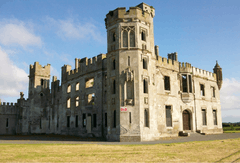Duckett's Grove
| Duckett's Grove | |
|---|---|
 | |
 | |
| General information | |
| Type | Country House |
| Location | County Carlow, Ireland |
| Coordinates | 52°51′27″N 6°48′46″W / 52.8575°N 6.8128°WCoordinates: 52°51′27″N 6°48′46″W / 52.8575°N 6.8128°W |
| Construction started | 1745 |
| Completed | 1825 |
| Owner | Government of Ireland |
| Design and construction | |
| Architect |
Thomas Cobden, John Macduff Derick |
| Website | |
|
www | |


Duckett's Grove is a ruined 19th-century great house and former estate in County Carlow, Ireland. Belonging to the Duckett family, it was formerly at the centre of a 12,000-acre (49 km2) estate, that dominated the landscape of the area for hundreds of years.[1]
History
Duckett's Grove was built around 1830 by William Duckett in an estate covering more than 5,000 acres (20 km2) of the County Carlow countryside, and was originally a two storey Georgian country house. Beginning in 1818, it was redesigned in a castellated Gothic revival style by Thomas Cobden for John Davidson Duckett.[2] This extension of the building was funded by a number of marriages into wealthy merchant families, and resulted in the Georgian features being removed or hidden.[3] The building incorporates a number of towers and turrets of varying shapes – round, square and octagonal.[4] One tall octagonal turret rises from the structure. Duckett’s Grove is elaborately ornamented with oriels and niches containing statues.[2] Several statues on pedestals surrounded the building and lined the approaches. The house is situated in the townland of Rainstown, approximately 10 km from Carlow and 9 km from Tullow, with the broader estate comprising several large townlands and parts of others. At its height the house had a staff of eleven men to maintain the grounds alone.[5]

After the death of William Duckett in 1908, the last male Duckett, his wife Maria Georgina Duckett lived on in the property until 1916. By this time she was no longer on speaking terms with her only daughter, Olive.[3] The outcome of this was the disinheritance of her daughter following her death 1937, leaving her what is known as "the angry shilling", just one shilling, from an estate valued at £97,735 at the time.[5] Following the departure of the Ducketts, the estate was managed by an agent until 1921, and was subsequently managed by local farmers, and later by the Land Commission.[6] The division and sale of the estate lands was completed by 1930. During the time the building was empty, it was used by the local IRA and its flying column.[7] Due to the Duckett's good treatment of their tenants and employees over the years, the interiors and furniture were left intact upon the IRAs departure from the house.[5] The Duckett's Grove house was destroyed by fire overnight on 20 April 1933.[2][3] The cause of the fire has not been determined,[6] however the locals reported a fire the week before, which they had managed to extinguish, leading to speculation about the cause of the eventual destructive fire.[5]
Current use
In September 2005, Carlow County Council acquired Duckett's Grove and commenced with the restoration of two inter-connecting walled gardens. It was officially opened in September 2007 for use as a public park.[8]
The first of the gardens, the "Upper Walled Garden", was planted with historical varieties of shrub roses and a collection of Chinese and Japanese peonies. It is mainly planted with flowering shrubs including Echium, Watsonia, Acanthus, Daphniphyllum, Acradenia, Arbutus, Cornus, Iris, Eryngium, Beschorneria and ornamental bananas.[9]

The second garden, the "Lower Walled Garden", was once the site of the family old orchard, and now contains a variety of fruits, including figs and historical varieties of Irish apples. The borders were planted to contain a variety of shrubs and perennials.[9][10]
On 17 March 2011, Duckett’s Grove was featured in an episode of SyFy's show "Destination Truth" during a 4-hour live investigation special to find out if the ruins are haunted by a Banshee Ghost.[11]
Duckett's Grove is open to the public during daylight hours and admission is free. There are tea rooms located in the courtyard which are often open during the weekend and for events, such as, the annual Christmas fair.
References
- ↑ Jackman, Neil. "Heritage Ireland: Who is this man with the frightfully fancy tomb?". The Journal. Retrieved 2 May 2015.
- 1 2 3 "Duckett's Grove, Carlow". Abandoned Ireland. Retrieved 2 May 2015.
- 1 2 3 McGrath, Thomas (2008). Carlow: History and Society. Dublin: Geography Publications. ISBN 9780906602386.
- ↑ "1830 – Duckett's Grove, Carlow, Co. Carlow". Archiseek. Retrieved 2 May 2015.
- 1 2 3 4 O'Toole, Jimmy (1993). The Carlow Gentry. Carlow: The Leinster Leader. ISBN 0952254409.
- 1 2 "Duckett's Grove history". Carlow County Museum. Retrieved 2 May 2015.
- ↑ Murray, Daniel. "Bushwhacked: The Loss of the Carlow Flying Column, April 1921". The Irish Story. Retrieved 2 May 2015.
- ↑ "Duckett's Grove gardens". Archived from the original on December 26, 2011.
- 1 2 "Duckett's Grove". Carlow Tourism. Retrieved 2 May 2015.
- ↑ "Duckett's grove walled gardens and pleasure grounds - Restoring the Gardens". Carlow Garden Trail. Retrieved 12 December 2012.
- ↑ "Castle prepares for ghost hunters siege". Irish Examiner. 22 April 2011. Retrieved 2 May 2015.
